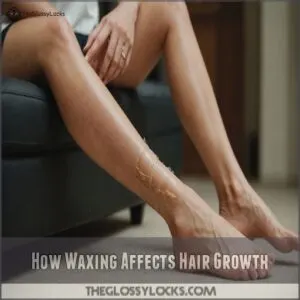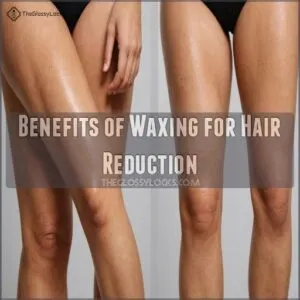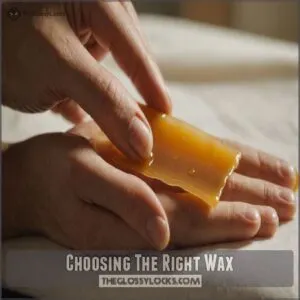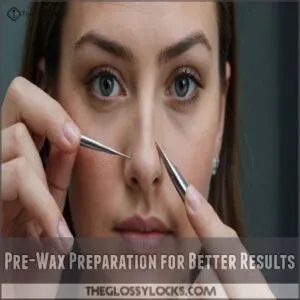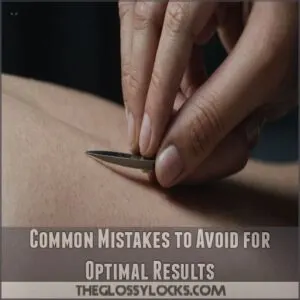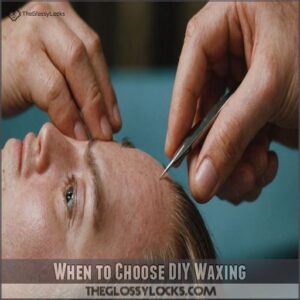This site is supported by our readers. We may earn a commission, at no cost to you, if you purchase through links.
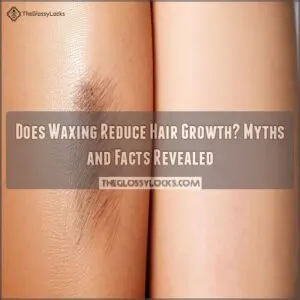
When you wax, you pull hair out from the root, which can make regrowth softer and finer.
Imagine trading in that old bristly hairbrush for a sleek new model.
However, don’t expect waxing to send your hair packing forever.
Hair might take a bit longer to come back, but it’ll eventually return.
So, while you’re not permanently evicting those follicles, waxing can keep things smoother for longer periods.
Curious about how to get the best results? Stay tuned for tips that might surprise you!
Table Of Contents
- Key Takeaways
- How Waxing Affects Hair Growth
- Benefits of Waxing for Hair Reduction
- Effective Waxing Techniques for Hair Reduction
- Common Mistakes to Avoid for Optimal Results
- Professional Waxing Vs. DIY: What’s Best for You
- Frequently Asked Questions (FAQs)
- Does waxing eventually stop hair from growing?
- What happens after years of waxing?
- Is wax better than shaving?
- Why does my pubic hair grow back so fast after waxing?
- How long does waxing last between sessions?
- Is waxing painful and how to ease it?
- Can waxing cause skin irritation or redness?
- Are there age limits for getting waxed?
- What are alternative methods to waxing?
- Conclusion
Key Takeaways
- When you wax, you’re pulling hair out from the root, which can make regrowth softer and finer over time.
- Regular waxing doesn’t stop hair growth forever, but it can weaken hair follicles, leading to slower and sparser regrowth.
- Effective waxing involves choosing the right wax and proper preparation and aftercare, resulting in smoother skin and slower regrowth.
- While DIY waxing saves money, professional waxing offers expertise and better results, especially for those with sensitive skin.
How Waxing Affects Hair Growth
When you wax, you pull hair out from the root, which might make it seem like hair grows back slower and finer.
However, while waxing doesn’t permanently reduce hair growth, it can lead to lighter and sparser regrowth over time, making you feel like your follicles are taking a well-deserved vacation.
The Science Behind Waxing
Ever wonder why waxing seems to slow hair growth?
It’s all about interrupting the hair follicle cycle.
By pulling hair from the root, waxing destabilizes the hair structure and can lead to fewer ingrown hairs.
Using waxing strips products can be a convenient way to achieve this effect at home.
Hormones affect hair growth rates, and surprisingly, you might notice a change in hair color over time—it’s like your follicles are playing tricks on you!
Does Waxing Permanently Reduce Hair Growth
You might wonder if waxing permanently reduces hair growth.
Well, it’s a common waxing myth.
While regular waxing weakens hair follicles over time, it doesn’t promise permanent effects like laser treatments.
Instead, it just slows things down a bit, giving you more control over hair growth cycles.
Consider these points:
- Temporarily stunted growth
- Weakening hair roots
- Longer hair-free periods
Factors Affecting Hair Regrowth After Waxing
While waxing doesn’t promise permanent hair growth reduction, it does depend on several factors such as the hair growth cycle, skin type, hormone levels, waxing frequency, and overall health.
Imagine hair regrowth as a team sport: each player affects the outcome.
Check out this table for more details:
| Factor | Impact on Regrowth |
|---|---|
| Hair Growth Cycle | Slower regrowth over time |
| Skin Type | Sensitive skin may react more |
| Hormone Levels | Influence hair density |
| Waxing Frequency | Regular sessions reduce growth |
Benefits of Waxing for Hair Reduction
When you wax, you’re not just removing hair; you’re tackling its regrowth head-on.
This method can lead to reduced hair thickness, slower regrowth, and the bonus of smoother skin for longer periods—making your efforts worthwhile!
Reduced Hair Thickness
The process of waxing can lead to noticeable changes in your hair. Over time, you might find your hair appears thinner. This isn’t magic; it’s due to the way waxing works.
Similarly, other hair removal methods, such as threading for hair reduction, can also weaken the hair shaft.
Here’s why:
- Repeated waxing can cause hair follicle damage, weakening the hair shaft.
- The hair growth cycle is disrupted, leading to thinner hair.
- You may experience hair texture changes, resulting in softer, less coarse hair.
Slower Hair Regrowth
After marveling at reduced hair thickness, you might wonder about regrowth speed.
Waxing actually slows it down considerably due to the disruption of the hair growth cycle.
Frequent waxing weakens hair follicles over time, causing hair to grow back finer and more slowly.
So, between waxes, you get longer breaks from dealing with pesky stubble or ingrown hairs.
Smoother Skin for Longer
Imagine stepping out with smoother skin that stays that way for longer periods.
Waxing not only slows hair regrowth but also enhances that feeling of silkiness we all crave.
Here’s why:
- Using an electric razor for ingrown hairs can minimize irritation and the risk of ingrown hairs. Fewer ingrown hairs reduce skin irritation.
- Consistent waxing leads to long-term results.
- Refined hair becomes less noticeable over time.
- Less frequent touch-ups compared to shaving.
Effective Waxing Techniques for Hair Reduction
To effectively reduce hair regrowth with waxing, focus on choosing the right wax and ensuring proper preparation and aftercare.
Choosing the right wax and proper preparation and aftercare are crucial for reducing hair regrowth with waxing.
By mastering these techniques, you’ll achieve smoother skin and potentially slower hair regrowth, making every waxing session worthwhile.
Choosing The Right Wax
Choosing the right wax can feel like picking your favorite ice cream flavor—options abound!
If you’re looking for the best waxing hair removal products, consider checking out a variety of waxing hair removal products.
If your skin is sensitive, consider hard wax; it’s gentler and excellent for smaller areas.
For larger areas, soft wax works wonders.
Pay attention to wax temperature to avoid burns.
Mastering your application techniques will help you achieve smoother results.
So, trial and error might save the day!
Pre-Wax Preparation for Better Results
Picked the right wax but now what? Let’s get your skin prepped for smooth results. Start with exfoliation to remove dead skin cells.
Make sure your hair length is about a quarter-inch.
A quick shower softens the hair, making waxing easier.
Don’t forget moisturizing – healthy skin waxes better.
Here’s a checklist to help:
- Exfoliation
- Right Hair Length
- Showering
- Moisturizing
- Calm & Comfortable Setting
Post-Wax Care for Reduced Regrowth
After waxing, take care by exfoliating gently to ward off ingrown hairs, while moisturizing keeps skin soft.
Don’t skip sun protection—it’s essential for maintaining healthy skin.
Pay attention to the hair growth cycle by booking routine waxes to reduce regrowth.
Pamper your skin like a prized garden, and it’ll thrive with less fuss and more smoothness!
Common Mistakes to Avoid for Optimal Results
Want the best results from waxing?
Let’s explore common mistakes that can hinder your progress, like shaving between appointments or using harsh skincare products.
Avoiding these pitfalls will help you achieve smoother, longer-lasting results.
Shaving Between Waxes
You’ve nailed effective techniques, now let’s tackle shaving between waxes.
It might seem like a quick fix, but it stirs up hair growth chaos.
Consider these pitfalls:
For smoother results, try prepping your skin with products designed for shaving after waxing, like those found at shaving after waxing products.
- Shaving frequency spikes hair texture impact.
- Irritation risks multiply with each shave.
- Waxing time frame extends unnecessarily.
- Alternative methods could save your skin and schedule!
Using Harsh Skin Products
Don’t let your skin pay the price for harsh products.
They may sound like magic potions, but some people find that using gentle shaving techniques, such as shaving with the grain, can help reduce skin irritation. They may sound like magic potions, but their ingredients can cause skin irritation or even chemical burns.
Sensitive skin folks, beware!
Reading labels isn’t just for cereal boxes.
Consider long-term effects and choose wisely to keep your skin calm and happy, not angry and red.
Neglecting Exfoliation and Moisturizing
Skipping exfoliation and moisturizing? You’re flirting with trouble.
Dry skin and ingrown hairs can turn waxing into a nightmare.
Without proper care, you risk uneven hair removal and skin irritation, leading to reduced effectiveness, especially when shaving sensitive areas like your booty shaving guide.
Think of your skin as a canvas—prep it well, and your waxing will paint a smoother picture.
Embrace these steps for fresher, softer results.
Professional Waxing Vs. DIY: What’s Best for You
Deciding between professional and DIY waxing can feel a bit like choosing between a chef’s steak and your own kitchen experiment—each has its perks and pitfalls.
You’ll discover how professional waxing offers expert results and why DIY might be right for those seeking convenience and cost-saving options.
The Benefits of Professional Waxing
Avoiding common mistakes sets the stage for exploring professional waxing benefits.
You might think of it as a spa day that’s relaxing but also effective for skin health.
To make sure you get the most out of your waxing experience, it’s important to address any issues that might hinder hair removal, like improper wax preparation or application techniques.
Professional waxing offers:
- Reduced pain – experienced technicians know their stuff!
- Better ingrown hair management.
- Long-term savings despite the upfront cost.
- Top-notch salon hygiene.
- To achieve extra-smooth skin, incorporating gentle pre-shave exfoliation techniques, such as those found in shaving tips for dry skin, can make a significant difference. Extra-smooth skin every time.
Risks of DIY Waxing
You found the perks of professional waxing intriguing, but let’s not sugarcoat DIY waxing’s risks.
Skin irritation, burns, and ingrown hairs often sneak up due to improper technique and lack of expertise.
Imagine wrestling a sticky situation only to end with allergic reactions.
Here’s a quick glance:
| Risk | Cause | Consequence |
|---|---|---|
| Skin irritation | Improper technique | Reddened skin |
| Burns | Overheated wax | Painful blisters |
| Ingrown hairs | Incorrect removal | Bumps and scars |
When to Choose DIY Waxing
With limited time and a small budget, DIY waxing might be appealing.
However, consider your experience level and pain tolerance.
If you lack confidence or have sensitive skin, professional waxing is safer.
Time constraints shouldn’t compromise safety.
A professional’s expertise guarantees a smoother, less painful experience, even if it costs more.
Ultimately, the best choice depends on your individual needs and priorities.
Frequently Asked Questions (FAQs)
Does waxing eventually stop hair from growing?
Waxing doesn’t stop hair growth permanently, but it can make hair finer and sparser over time.
Hair regrows at different rates for everyone, but regular waxing might give you some freedom from constant shaving.
What happens after years of waxing?
Over years of waxing, hair might grow back finer and sparser as some follicles stop producing hair.
Results vary by person.
Think of it like training your skin to embrace smoothness while slowly waving goodbye to unwanted fuzz.
Is wax better than shaving?
Choosing between wax and shaving depends on your preference and skin type.
Waxing pulls hair from the root, leading to slower regrowth and smoother skin.
Shaving is quick and painless but requires frequent repetition.
Choose wisely!
Why does my pubic hair grow back so fast after waxing?
Protective styling with braids for hair growth can minimize breakage and reduce manipulation, creating an environment conducive to length retention. Your pubic hair might grow back fast after waxing due to hair growth cycles.
Everyone’s hair grows at different rates, influenced by genetics and hormones.
Regular waxing can eventually lead to slower, finer regrowth over time.
How long does waxing last between sessions?
Think waxing’s a fleeting fix? It’s not!
You’ll enjoy smooth skin for three to six weeks, depending on your hair growth cycle.
That’s a decent amount of time before you need another session.
Is waxing painful and how to ease it?
Waxing can sting, like a bandaid coming off, but you’ve got this!
Numb the area with an ice pack or take ibuprofen beforehand.
Breathe deeply and relax—distraction helps too.
It’ll be smoother sailing soon!
Can waxing cause skin irritation or redness?
Experiencing redness or irritation from waxing isn’t uncommon, happening to about 60% of people.
Those sensitive spots can sting, but soothing aloe or a cool gel often does the trick.
Keep calm and pamper your skin!
Are there age limits for getting waxed?
Generally, there aren’t strict age limits for waxing, but it’s wise to wait until puberty, when hair growth stabilizes.
Parental consent is key for minors.
That first wax can be a bit like a welcome-to-adulthood rite!
What are alternative methods to waxing?
Imagine bidding farewell to waxing with gentler alternatives like shaving, sugaring, and depilatory creams.
For something more permanent, consider laser hair removal or electrolysis.
They each have their quirks, so find what fits your skin and schedule best.
Conclusion
Think of waxing like swapping out a rough scratchpad for a smoother option; it’s about efficiency, not permanent change.
While waxing doesn’t reduce hair growth permanently, it definitely impacts how hair comes back.
By tearing hair out from the root, waxing can lead to finer and less noticeable regrowth over time.
Choosing the right techniques and avoiding common pitfalls will help you make the most of your waxing routine.
So, does waxing reduce hair growth? It’s complicated, but effective for smoother skin.

